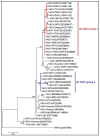Vaccinia Virus Natural Infections in Brazil: The Good, the Bad, and the Ugly
- PMID: 29140260
- PMCID: PMC5707547
- DOI: 10.3390/v9110340
Vaccinia Virus Natural Infections in Brazil: The Good, the Bad, and the Ugly
Abstract
The orthopoxviruses (OPV) comprise several emerging viruses with great importance to human and veterinary medicine, including vaccinia virus (VACV), which causes outbreaks of bovine vaccinia (BV) in South America. Historically, VACV is the most comprehensively studied virus, however, its origin and natural hosts remain unknown. VACV was the primary component of the smallpox vaccine, largely used during the smallpox eradication campaign. After smallpox was declared eradicated, the vaccination that conferred immunity to OPV was discontinued, favoring a new contingent of susceptible individuals to OPV. VACV infections occur naturally after direct contact with infected dairy cattle, in recently vaccinated individuals, or through alternative routes of exposure. In Brazil, VACV outbreaks are frequently reported in rural areas, affecting mainly farm animals and humans. Recent studies have shown the role of wildlife in the VACV transmission chain, exploring the role of wild rodents as reservoirs that facilitate VACV spread throughout rural areas. Furthermore, VACV circulation in urban environments and the significance of this with respect to public health, have also been explored. In this review, we discuss the history, epidemiological, ecological and clinical aspects of natural VACV infections in Brazil, also highlighting alternative routes of VACV transmission, the factors involved in susceptibility to infection, and the natural history of the disease in humans and animals, and the potential for dissemination to urban environments.
Keywords: ecology; host range; natural infections; orthopoxvirus; public health; smallpox vaccine; vaccinia virus; zoonosis.
Conflict of interest statement
The authors declare that there is no conflict of interest of any kind. The opinions expressed by authors contributing to this journal do not necessarily reflect the opinions of the institutions with which the authors are affiliated.
Figures





References
-
- Damon I. Poxviruses. Lippincott-Raven; Philadelphia, PA, USA: 2013. pp. 2160–2184.
-
- Fenner F., Henderson D. Smallpox and Its Eradication. World Health Organization; Geneva, Switzerland: 1988.
-
- Henderson D., Preston R. Smallpox: The Death of a Disease—The Inside Story of Eradicating a Worldwide Killer. 1st ed. Prometheus Books; Amherst, NY, USA: 2009.
Publication types
MeSH terms
LinkOut - more resources
Full Text Sources
Other Literature Sources
Medical
Research Materials

